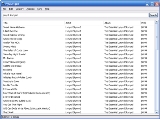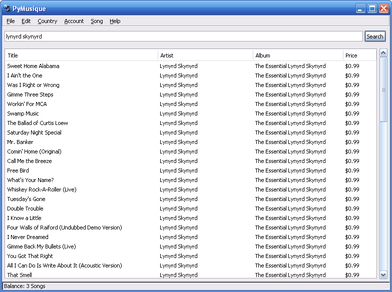
SharpMusique
Encyclopedia

Python (programming language)
Python is a general-purpose, high-level programming language whose design philosophy emphasizes code readability. Python claims to "[combine] remarkable power with very clear syntax", and its standard library is large and comprehensive...
by Travis Watkins, Cody Brocious
Cody Brocious
-Biography:Cody William Brocious was born in Waukegan, Illinois, the son of a Naval Drug and Alcohol counselor. He moved to Chambersburg, Pennsylvania at the age of 3 and became interested in computing by the age of 4...
, and Jon Lech Johansen
Jon Lech Johansen
Jon Lech Johansen , also known as DVD Jon, is a Norwegian programmer famous for his work on reverse engineering data formats....
for the purpose of allowing downloading songs from the iTunes Music Store before DRM
Digital rights management
Digital rights management is a class of access control technologies that are used by hardware manufacturers, publishers, copyright holders and individuals with the intent to limit the use of digital content and devices after sale. DRM is any technology that inhibits uses of digital content that...
was applied to them from a Mac, Linux
Linux
Linux is a Unix-like computer operating system assembled under the model of free and open source software development and distribution. The defining component of any Linux system is the Linux kernel, an operating system kernel first released October 5, 1991 by Linus Torvalds...
, or Windows computer. It was first released via Johansen's website on March 18, 2005. Although the iTunes Music Store's method of applying FairPlay
FairPlay
FairPlay is a digital rights management technology created by Apple Inc., based on technology created by the company Veridisc. FairPlay is built into the QuickTime multimedia software and used by the iPhone, iPod, iPad, Apple TV, iTunes, and iTunes Store and the App Store. Formerly, all songs in...
DRM to the songs was widely known, PyMusique was the first program to exploit a loophole in the system, allowing users to download songs without the DRM restriction. On March 22, 2005, Apple released an update that rendered PyMusique non-functional. The same day, a new version of PyMusique was released that worked again, only without Windows compatibility. On March 31, 2005, Johansen released SharpMusique, the Windows-compatible port of PyMusique.
PyMusique also allowed songs to be re-downloaded for free, in case a user accidentally deleted their purchase. Within a number of days, Apple broke the client by forcing all users to upgrade to iTunes
ITunes
iTunes is a media player computer program, used for playing, downloading, and organizing digital music and video files on desktop computers. It can also manage contents on iPod, iPhone, iPod Touch and iPad....
4.9 . In response to Apple's actions, Johansen released PyMusique version 0.4 on March 22, 2005 http://nanocrew.net/?p=15, which allows users once again to use PyMusique with Apple's store.
With the launch of 0.4, developer Cody Brocious stated on his blog that no future versions of PyMusique would be released with Microsoft Windows
Microsoft Windows
Microsoft Windows is a series of operating systems produced by Microsoft.Microsoft introduced an operating environment named Windows on November 20, 1985 as an add-on to MS-DOS in response to the growing interest in graphical user interfaces . Microsoft Windows came to dominate the world's personal...
support.
In September 2005, Jon Lech Johansen released SharpMusique, written in C#, which took over where PyMusique left off. The program was kept updated until version 1.0, at which point it was no longer updated. The iTunes protocol changed, and users of SharpMusique were able to release primitive patches to account for the changes until mid 2006, when the protocol changed drastically. Around this time, without public announcement, the download links for SharpMusique and its source were removed from Johansen's website . As a result, it is no longer easily available.
External links
- Forbes.com article on Cody Brocious and PyMusique
- Neowin.net interview with Cody Brocious[Broken link]
- SharpMusique with links deep in the comments to source packages for linux and windows

